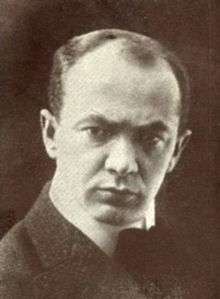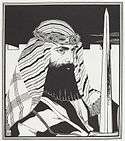Ephraim Moses Lilien
| Ephraim Moses Lilien | |
|---|---|
 Ephraim Moshe Lilien | |
| Born | 1874 |
| Died | 1925 |
| Education |
Academy of Arts in Kraków Academy of Fine Arts Vienna |
| Known for | Illustrator and Print-maker |
| Movement | Israeli art |
Ephraim Moses Lilien (1874–1925) was an art nouveau illustrator and printmaker particularly noted for his art on Jewish themes. He is sometimes called the "first Zionist artist."[1]
Biography
Ephraim Moses Lilien (Maurycy Lilien) was born in Drohobycz, Galicia in 1874. In 1889-1893 Lilien learned painting and graphic techniques at the Academy of Arts in Kraków. He studied under Polish painter Jan Matejko from 1890 to 1892.
As a member of the Zionist Movement, Lilien traveled to Ottoman Palestine several times between 1906 and 1918.[2] He accompanied Boris Schatz to Jerusalem to help establish the Bezalel Art School.[1]
Lilien was one of the two artists to accompany Boris Schatz to what is now Israel in 1906 for the purpose of establishing Bezalel Academy of Arts and Design, and taught the school's first class in 1906. Although his stay in the country was short-lived, he left his indelible stamp on the creation of an Eretz Israel style, placing biblical subjects in the Zionist context and oriental settings, conceived in an idealized Western design. In the first two decades of the century, Lilien's work served as a model for the Bezalel group.
Lilien is known for his famous photographic portrait of Theodor Herzl. He often used Herzl as a model, considering his features a perfect representation of the "New Jew."[3] In 1896, he received an award for photography from the avantgarde magazine Jugend. Lilien illustrated several books. In 1923, an exhibition of his work opened in New York.[2]
Lilien's illustrated books include Juda (1900), Biblically-themes poetry by Lilien's Christian friend, Börries Freiherr von Münchausen, and Lieder des Ghetto (Songs of the Ghetto) (1903), Yiddish poems by Morris Rosenfeld translated into German.
Lilien died in Badenweiler, Germany in 1925. A street in the Nayot neighborhood of Jerusalem is named for him.
Gallery
 "Sunflower" (Sonnenblume), Jugend, Berlin, 1893
"Sunflower" (Sonnenblume), Jugend, Berlin, 1893 Ex libris Stefan Zweig c. 1900
Ex libris Stefan Zweig c. 1900 "The Queen of Sabbath", from Juda, Berlin, 1900-1
"The Queen of Sabbath", from Juda, Berlin, 1900-1 "The Silent Song" from Juda, 1900-1.[4]
"The Silent Song" from Juda, 1900-1.[4] 'May our eyes behold your return in mercy to Zion, First Zionist Congress souvenir, Basel, 1901.[5]
'May our eyes behold your return in mercy to Zion, First Zionist Congress souvenir, Basel, 1901.[5] Herzl in Basel, 1901. Photograph (reproduced as a postcard).
Herzl in Basel, 1901. Photograph (reproduced as a postcard). Ost und West, 1903
Ost und West, 1903 Homage to the victims of the Kishinev Pogrom, 1903.[6]
Homage to the victims of the Kishinev Pogrom, 1903.[6] Jewish child from Lieder des Ghetto, 1903
Jewish child from Lieder des Ghetto, 1903 "Zion", Lieder des Ghetto, 1903
"Zion", Lieder des Ghetto, 1903 Ex libris Boris Schatz, 1905
Ex libris Boris Schatz, 1905 Emblem of the Bezalel Academy of Arts and Design, Jerusalem, 1906
Emblem of the Bezalel Academy of Arts and Design, Jerusalem, 1906 An Allegorical Wedding: Sketch for a carpet Triptych (from right to left): Exile, Marriage, Redemption, 1906
An Allegorical Wedding: Sketch for a carpet Triptych (from right to left): Exile, Marriage, Redemption, 1906 Portrait, photograph, 1906
Portrait, photograph, 1906 Joshua, 1908
Joshua, 1908 Abraham, 1908
Abraham, 1908 Balaam, [1908]
Balaam, [1908] Dybbuk, [1908]
Dybbuk, [1908]- Kotel (Western Wall), 1910
 In the Library, engraving, 1915
In the Library, engraving, 1915
 Learning Talmud, engraving, 1915
Learning Talmud, engraving, 1915 Figures, photograph, c. 1918
Figures, photograph, c. 1918 The Samaritan, engraving, c. 1920
The Samaritan, engraving, c. 1920
References
- 1 2 Haim Finkelstein, Lilien and Zionism
- 1 2 On Ephraim Moses Lilien
- ↑ Artistic Expressions of the Jewish Renaissance
- ↑ Levussove, New Art of an Ancient People: Lilien, p. 12: "The Silent Song".
- ↑ Image published in Ost und West, Berlin, January 1902, 17-18.
- ↑ Image published in Ost und West, December 1904, 848-850.
External links
| Wikimedia Commons has media related to Ephraim Moshe Lilien. |
- Ephraim Lilien collection at the Israel Museum. Retrieved {{{accessdate}}}
- "Ephraim Moses Lilien". Information Center for Israeli Art. Israel Museum. Retrieved {{{accessdate}}}. Check date values in:
|access-date=(help) - Moses Art of Ephraim Moses Lilien at Europeana. Retrieved {{{accessdate}}}
- Illustrations in "Lieder des Ghetto"
- Ephraim Moses Lilien Collection at the Leo Baeck Institute, New York